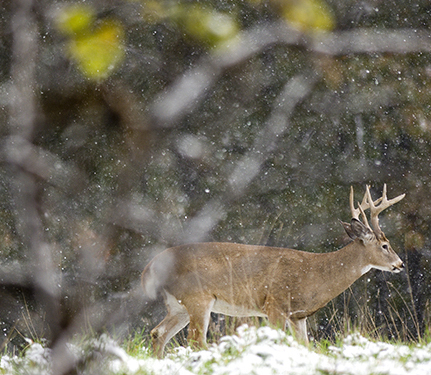Modern Muzzleloaders Take to the Woods in Michigan
By Glen Wunderlich
Outdoor Columnist
Member Professional Outdoor Media Association
Muzzleloading season is underway and more and more Michigan deer hunters are enjoying its rewards. In the Southern Lower Peninsula (Zone III), the season runs from December 3 – 19 – a week longer than in years past. The Northern Lower Peninsula’s season (Zone II) is December 10 – 19, while the Upper Peninsula’s (Zone I) season covers December 10 – 19. Reasons for the increased favor of smokepoles are many but most of all, it boils down to effectiveness.
At the top of the list has to be the technological advances in modern muzzleloaders, propellants, and bullet choices. While traditionalists may look down their noses at the growing contingent of modern, in-line muzzleloaders, they are here to stay. The modern front-loading rifles pack more punch than their black-powder counterparts at longer ranges and do it with accuracy and simplicity – both elements of their popularity.
I don’t refer to the season as black powder season any more than I do to the rifles as black powder rifles. It’s muzzleloading season and it’s muzzleloaders! The black powder of yesteryear stinks, is filthy, fouls bores quickly and destroys them routinely with its sulfur content, if not thoroughly cleaned immediately after use. Is it any wonder that today’s muzzleloading enthusiasts opt for black powder substitutes that eliminate the inherent caustic properties of real black powder, or even Pyrodex? Move over Daniel Boone!
My personal smokepoles has been a Knight Revolution (no longer in production), which uses Remington shotgun-style 209 primers but are actually formulated specifically for muzzleloaders. It’s good to experiment with primers, because heat ranges differ, as do results. Same with powder. My current load is 140 grains of Hodgdon fff Triple 7, which pushes a 250-grain tipped Barnes bullet at a sizzling 2175 feet per second. This speed translates into trajectory of 3 inches high at 100 yards and is still in the 6-inch kill zone at 200 yards. That’s serious stuff with retained energy of 1240 foot pounds at 200 yards, too! And, accuracy rivals a decent centerfire rifle.
No accuracy buff uses pellets, which have become almost synonymous with today’s in-line muzzleloaders. Certainly, they are more convenient but consistency can be less than granular style powder. In addition, granular powder can be measured to any fractional level desired. With pellets, the shooter is stuck with increments of 30 to 50 grains. However, loading for hunting is only done once, so what’s the big attraction with pellets anyway?
Measuring granular powder, while bench testing is a bit slower, but speed loaders can assist reloading quickly afield. It’s important to watch the deer as long as you can after firing, then reload. Why should anyone reload? Simple. It should be a rule of thumb after firing afield, even if your deer appears to be down for the count. Many are lost because hunters didn’t reload, while the prize regains its senses and scurries off. Don’t be that guy!
Even though muzzleloader success last year was at 19 percent and only 6 percent of bucks were taken during the season, it’s still a great time to balance the doe to buck ratio by removing some of the does from the herd. Caution must be taken, however, to look for bucks that have already shed their antlers by paying careful attention to the top of deers’ heads. Antler nubs can still be seen with good optics and appear to square-off their heads, while does have rounded heads. Also, remember that button bucks (male fawns) often travel alone and have the telltale squared-off heads.
One of the best features of late-season hunting is that deer are not as jumpy and often present better opportunities. With the single-shot front loaders, hunters are urged to take their time and identify their target, because once that trigger is pulled, the bullet cannot be called back.
For box blind hunters that want an accuracy advantage, check out my blog post of November 25th, “A Tip for Box Blind Hunters” at http://thinkingafield.blogspot.com/2010/11/tip-for-box-blind-hunters.html. You can thank me later.






